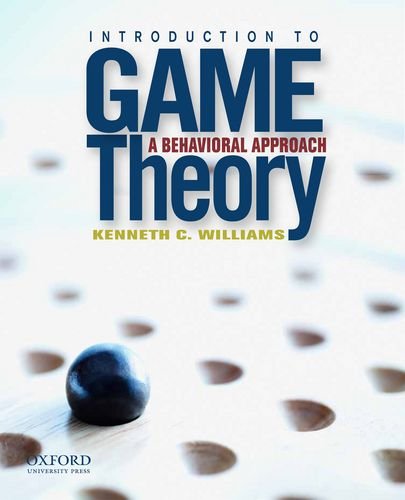
Sinossi
Game theory studies the strategic interaction of people within various institutions such as political, economic, or other social institutions that are governed by a set or rules or principals. Game theory provides solutions to these strategic interactions by developing models based on assumptions about human behavior and the institution where the interaction occurs. Game theory is an interdisciplinary method to examine decision making in the fields of economics, political science, psychology, sociology, mathematics, computer programming, and biology.
This book is an introduction to game theory but differs from other excellent introduction game theory texts by taking a behavioral approach. This means that basic game theory concepts are explained by using results from laboratory experiments that examine how real people behave when they participate in the games that are modeled. This approach is referred to as behavioral game theory and it seeks to use psychological reasoning to explain deviations in the predictions of standard game theory models. Behavior game theory allows for the study of how human emotions affect decision making using the assumptions of game theory.
Although the study of game theory is somewhat technical because it uses mathematics to construct the various models, the intuition behind game theory is actually normative and nontechnical. This book takes a very nontechnical approach to the study of game theory so that only minimum math skills are needed to follow the discussion in the book. The importance of game theory lies in the deductive process of reasoning and understanding how to construct models of social interaction, and not the mathematics that are involved.
Le informazioni nella sezione "Riassunto" possono far riferimento a edizioni diverse di questo titolo.
Informazioni sull?autore
Kenneth C. Williams is a professor of political science at Michigan State University. He received his PhD from the University of Texas at Austin and did a postdoctoral fellowship at Massachusetts Institute of Technology. He has taught at the University of California at Santa Barbara, The University of London, the University of Edinburg, and Trinity College in Dublin. He is co-author of Experimental Political Science and the Study of Causality, Cambridge University Press (with Rebecca B. Morton), and the winner of the 2011 book of the year award from the experimental section of the American Political Science Association. He is also co-author of Learning by Voting: Sequential Choices in Presidential Primaries and Other Elections, University of Michigan Press (with Rebecca B. Morton).
Le informazioni nella sezione "Su questo libro" possono far riferimento a edizioni diverse di questo titolo.
Altre edizioni note dello stesso titolo
Risultati della ricerca per Introduction to Game Theory: A Behavioral Approach:...
Introduction to Game Theory: A Behavioral Approach: International Edition (eng)
Da: Brook Bookstore On Demand, Napoli, NA, Italia
Condizione: new. Questo è un articolo print on demand. Codice articolo a17800c519695cba78b49add1765e87c
Compra nuovo
Quantità: Più di 20 disponibili
Introduction to Game Theory: A Behavioral Approach: International Edition
Da: THE SAINT BOOKSTORE, Southport, Regno Unito
Paperback / softback. Condizione: New. New copy - Usually dispatched within 4 working days. 492. Codice articolo B9780199837410
Compra nuovo
Quantità: 15 disponibili
Williams, K: Introduction to Game Theory: A Behavioral Appro
Da: moluna, Greven, Germania
Kartoniert / Broschiert. Condizione: New. Dieser Artikel ist ein Print on Demand Artikel und wird nach Ihrer Bestellung fuer Sie gedruckt. This book is an introduction to game theory but differs from other introductory game theory texts by taking a behavioural approach.Über den AutorrnrnKenneth C. Williams is a professor of political science at Michigan State University. H. Codice articolo 594434730
Compra nuovo
Quantità: Più di 20 disponibili
Introduction to Game Theory | A Behavioral Approach (Revised)
Print on DemandDa: preigu, Osnabrück, Germania
Taschenbuch. Condizione: Neu. Introduction to Game Theory | A Behavioral Approach (Revised) | Kenneth C Williams | Taschenbuch | Englisch | 2012 | Oxford University Press | EAN 9780199837410 | Verantwortliche Person für die EU: Libri GmbH, Europaallee 1, 36244 Bad Hersfeld, gpsr[at]libri[dot]de | Anbieter: preigu Print on Demand. Codice articolo 134191489
Compra nuovo
Quantità: 5 disponibili
Introduction to Game Theory : A Behavioral Approach (Revised)
Print on DemandDa: AHA-BUCH GmbH, Einbeck, Germania
Taschenbuch. Condizione: Neu. nach der Bestellung gedruckt Neuware - Printed after ordering - Game theory studies the strategic interaction of people within various institutions such as political, economic, or other social institutions that are governed by a set or rules or principals. Game theory provides solutions to these strategic interactions by developing models based on assumptions about human behavior and the institution where the interaction occurs. Game theory is an interdisciplinary method to examine decision making in the fields of economics, political science, psychology, sociology, mathematics, computer programming, and biology. This book is an introduction to game theory but differs from other excellent introduction game theory texts by taking a behavioral approach. This means that basic game theory concepts are explained by using results from laboratory experiments that examine how real people behave when they participate in the games that are modeled. This approach is referred to as behavioral game theory and it seeks to use psychological reasoning to explain deviations in the predictions of standard game theory models. Codice articolo 9780199837410
Compra nuovo
Quantità: 1 disponibili

